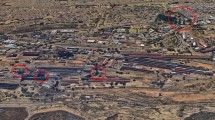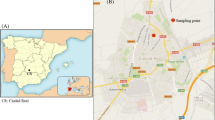Abstract
The aim of this study was to characterize the PM2.5-bound polycyclic aromatic hydrocarbon (PAH) concentrations and their diagnostic ratios in an area impacted by light-duty vehicles fueled by neat ethanol and ethanol-blended gasoline. Samples were collected using a high-volume sampler, extracted, and analyzed for all 16 EPA-priority PAHs using gas chromatography/mass spectrometry (GC/MS) following the EPA 3550B Method. The most abundant PAHs were benzo[g,h,i]perylene, benzo[b]fluoranthene, benzo[a]pyrene and indeno[1,2,3-c,d]pyrene. The total mean concentration was 3.80 ± 2.88 ng m−3, and the contribution of carcinogenic species was 58 ± 16 % of the total PAHs. The cumulative health hazard from the PAH mixture was determined, and the carcinogenic equivalents and mutagenic equivalents were 0.80 ± 0.82 and 1.17 ± 1.04 ng m−3, respectively. Diagnostic ratios and normalized ratios were calculated for the individual samples.

Similar content being viewed by others
References
Abrajano TA Jr, Yan B (2007) High molecular weight petrogenic and pyrogenic hydrocarbons in aquatic environments. In: Lollar BS (ed) Environmental geochemistry, 2nd edn. Elsevier, Oxford, pp 475–509
Allen AG, da Rocha GO, Cardoso AA, Partelini WC, Machado CMD, de Andrade JB (2008) Atmospheric particulate polycyclic aromatic hydrocarbons from road transport in southeast Brazil. Transp Res Part D 13:483–490
Collins JF, Brown JP, Alexeff GV, Salmon AG (1998) Potency equivalency factors for some polycyclic aromatic hydrocarbons and polycyclic aromatic hydrocarbons derivatives. Regul Toxicol Pharm 28:45–54
Correa SM, Arbilla G (2006) Aromatic hydrocarbons emissions in diesel and biodiesel exhaust. Atmos Environ 40:6821–6826
Da Rocha GO, Lopes WA, Pereira PAP, Vasconcellos PC, Oliveira FS, Carvalho LS, Conceição LS, de Andrade JB (2009) Quantification and source identification of atmospheric particulate polycyclic aromatic hydrocarbons and their dry deposition fluxes at three sites in Salvador Basin, Brazil, impacted by mobile and stationary sources. J Braz Chem Soc 20:680–692
de Abrantes R, de Assunção JV, Pesquero CR, Bruns RE, Nóbrega RP (2008) Emission of polycyclic aromatic hydrocarbons from gasohol and ethanol vehicles. Atmos Environ 43:648–654
de Abrantes R, Assunção JV, Pesquero CR, Bruns RE, Nobrega RP (2009) Emission of polycyclic aromatic hydrocarbons from gasohol and ethanol vehicles. Atmos Environ 43:648–654
Durant JL, Busby WF Jr, Lafleur AL, Penman BW, Crespi CL (1996) Human cell mutagenicity of oxygenated, nitrated and unsubstituted polycyclic aromatic hydrocarbons associated with urban aerosols. Mutat Res Genetic Toxicol 371:123–157
Dutcher DD, Pagels J, Bika A, Luke F, Stolzenburg M, Thompson S, Medrano J, Brown N, Gross DS, Kittelson D, McMurry PH (2011) Emissions from soy biodiesel blends: a single particle perspective. Atmos Environ 45:3406–3413
EPA (1996a) Environmental Protection Agency 3550B – Ultrasonic extraction. Revision 2. http://www.trincoll.edu/~henderso/textfi~1/416%20notes/3550b.pdf. Accessed 1 June 2013
EPA (1996b) Environmental Protection Agency, method 8270c. Semivolatile organic compounds by gas chromatography/mass spectrometry (GC/MS). Revision 3. http://www.caslab.com/EPA-Methods/PDF/8270c.pdf. Accessed 1 June 2013
Fu S, Zhong-Zhi Y, Li K, Xiao-Bai X (2010) Spatial characteristics and major sources and polycyclic aromatic hydrocarbons from soil and respirable particulate matter in a mega-city, China. Bull Environ Contam Toxicol 85:15–21
Khalili NR, Scheff PA, Holsen TM (1995) PAH source fingerprints for coke ovens, diesel and gasoline engines, highway tunnels, and wood combustion emissions. Atmos Environ 29:533–542
Li CK, Kamens RM (1993) The use of polycyclic aromatic hydrocarbons as source of signatures in receptor modeling. Atmos Environ 27A:523–532
Li Z, Porter EN, Sjodin A, Needham LL, Lee S, Rusell AG, Mulholland JA (2009) Characterization of PM2.5- bound polycyclic aromatic hydrocarbons in Atlanta-seasonal variations at urban, suburban and rural ambient air monitoring sites. Atmos Environ 43:4187–4193
Lima FM, Netto ADP (2009) Annual variation of total suspended particulate and associated polycyclic aromatic hydrocarbons in the tropical city of Niterói, RJ, Brazil. J Braz Chem Soc 20:488–495
Loyola J, Arbilla G, Quiterio SL, Escaleira V, Minho AS (2012) Trace metals in the urban aerosols of Rio de Janeiro city. J Braz Chem Soc 23:628–638
Martellini T, Giannoni M, Lepri L, Katsoyiannis A (2012) One year intensive PM2.5 bound polycyclic aromatic hydrocarbons monitoring in the area of Tuscany, Italy. Concentrations, source understanding and implications. Environ Pollut 164:252–258
MNE (2009) Minister of Natural Environment. First national emission inventory. Final report. http://www.mma.gov.br/estruturas/163/_publicacao/163_publicacao27072011055200.pdf. Accessed 1 February 2014
Mohanraj R, Solaraj G, Dhanakumar S (2011) PM2.5 and PAH concentration in urban atmosphere of Tiruchirappalli. India. Bull Environ Contam Toxicol 87:330–335
Nisbet ICT, LaGoy PK (1992) Toxic equivalency factors (TEFs) for polycyclic aromatic hydrocarbons (PAHs). Regul Toxicol Pharmacol 16:290–300
Oliveira RL, Varandas L, Arbilla G (2014) Characterization of polycyclic aromatic hydrocarbon levels in the vicinity of a petrochemical complex located in a densely populated area of the Rio de Janeiro, Brazil. Atmos Poll Res 5:87–95
Pandey PK, Patel KS, Lenicek J (1999) Polycyclic aromatic hydrocarbons: need for assessment of health risks in India? Study of an urban-industrial location in India. Environ Mon Assess 59:287–319
Park SS, Kim YJ, Kang CH (2012) Atmospheric polycyclic aromatic hydrocarbons in Seoul, Korea. Atmos Environ 36:2917–2924
Pistikopoulos P, Masclet P, Mouvier G (1990) A receptor model adapted to reactive species: polycyclic aromatic hydrocarbons; evaluation of sources contributions in an open urban site-1, particle compounds. Atmos Environ 24:1189–1197
Rainho CR, Velho AM, Correa SM, Mazzei JL, Aiub CAF, Felzenswalb I (2013) Prediction of health risk due to polycyclic aromatic hydrocarbons present in urban air in Rio de Janeiro, Brazil. Genet Mol Res 12:3992–4002
Ravindra K, Sokhi R, Van Grieken R (2008) Atmospheric polycyclic aromatic hydrocarbons: source attribution, emission factors and regulation. Atmos Environ 42:2895–2921
REDEMET (2010) Aeronautical Meteorology Services Network. Available in: http://www.redemet.aer.mil.br/. Accessed in 2010
Rogula-Kozłowska W, Kozielska B, Klejnowski K (2013) Concentration, origin and health hazard from fine particle-bound PAH at three characteristic sites in Southern Poland. Bull Environ Contam Toxicol 91:349–355
Slezakova K, Castro D, Begonha A, Delerue-Matos C, Alvim-Ferraz MDC, Morais S, Pereira MDC (2011) Air pollution from traffic emissions in Oporto, Portugal: health and environmental implications. Microchem J 99:51–59
Sofowote UM, Allan LM, McCarry BE (2010) Evaluation of PAH diagnostic ratios as source apportionment tools for air particulates collected in an urban-industrial environment. J Environ Monit 12:417–424
Tavares M Jr, Pinto JP, Souza AL, Scarmínio IS, Solci MC (2004) Emission of polycyclic aromatic hydrocarbons from diesel engine in a bus station, Londrina, Brazil. Atmos Environ 38:5039–5044
Tobiszewski M, Namiesnik J (2012) PAH diagnostic ratios for the identification of pollution emission sources. Environ Pollut 162:110–119
WHO (1987) Polynuclear aromatic hydrocarbons (PAH). Air quality guidelines for Europe. WHO Regional Office for Europe, Copenhagen, pp 105–117
Yunker MB, Macdonald RW, Vingarzan R, Mitchell RH, Goyette D, Sylvestre S (2002) PAHs in the Fraser River basin: a critical appraisal of PAH ratios as indicators of PAH source and composition. Org Geochem 33:489–515
Zielinska B (2005) Atmospheric transformation of diesel emissions. Toxicol Pathol 57:31–42
Acknowledgments
The study was funded in part by FAPERJ, CNPq and CAPES. We also acknowledge D.Sc. Luciana S. Varandas da Silva and Carlos A. Bulchi Ribeiro for helping with sample analysis.
Author information
Authors and Affiliations
Corresponding author
Rights and permissions
About this article
Cite this article
Oliveira, R.L., Loyola, J., Minho, A.S. et al. PM2.5-Bound Polycyclic Aromatic Hydrocarbons in an Area of Rio de Janeiro, Brazil Impacted by Emissions of Light-Duty Vehicles Fueled by Ethanol-Blended Gasoline. Bull Environ Contam Toxicol 93, 781–786 (2014). https://doi.org/10.1007/s00128-014-1409-0
Received:
Accepted:
Published:
Issue Date:
DOI: https://doi.org/10.1007/s00128-014-1409-0




